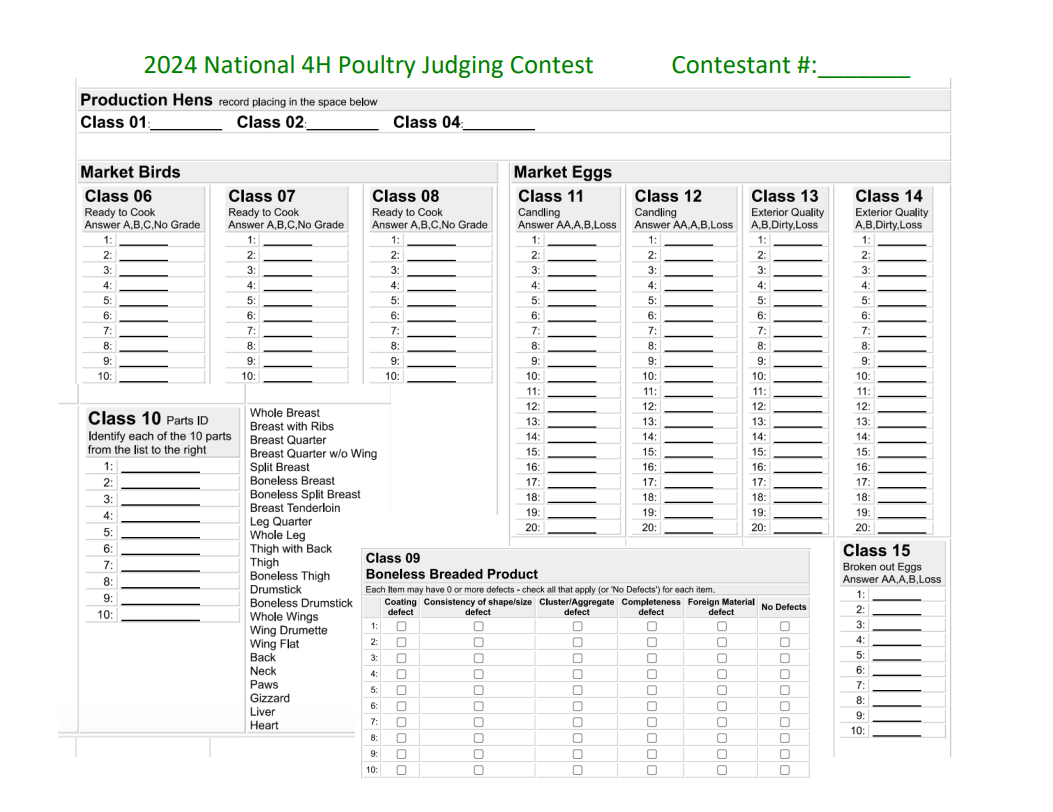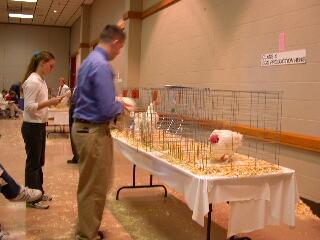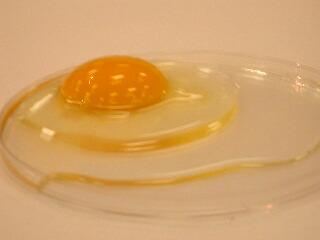Poultry Judging
PLEASE NOTE - THE NATIONAL 4-H POULTRY JUDGING CONTEST HAS SIGNIFICANT CHANGES STARTING WITH THE NOVEMBER 2021 CONFERENCE. The past manual sold by the University of Nebraska is no longer applicable to the national contest. The new manual is only available online.
NATIONAL 4-H POULTRY JUDGING CONTENT MANUAL
(Special Awards provided by U.S. Poultry & Egg Association)
PURPOSE OF CONTEST:
- To develop youth and help them learn the techniques of logical, accurate decision making; to learn to recognize the reasons for their decisions, and to develop the ability to express their reasons orally.
- To help youth learn and understand standards used in poultry and egg production and marketing, and to apply the standards in a realistic decision-making situation.
- To serve as an award activity and trip for youth who have achieved superior levels of performance in-state competition and thus stimulate the learning process, interest, and enthusiasm.
- To help youth with career guidance.
- To promote the poultry industry.
RULES AND INFORMATION SPECIFIC TO THE POULTRY JUDGING CONTEST:
- Each state is eligible to enter a team of three (3) or four (4) bona fide 4-H members and/or one (1) independent individual in the national contest. The individual cannot compete on a state team once registered for the contest and is ineligible to compete in the national poultry judging contest again. If a state has NO team they may enter up to two (2) individuals.
- Contestants need not be enrolled in poultry projects and are not required to have conducted a poultry project in the current year.
- Scoring for the contest will be done electronically. Each participant will be given a score sheet to use while judging and then will enter their choices into the electronic system. A practice page (with a downloadable score sheet) has been developed for the contest and is available at https://secure.georgia4h.org/poultrynational/practice/practiceinstructions.cfm).

Resources:
- 2022 version of the USDA Poultry Picture Series: A guide to the U.S. Graded chicken (First Edition) (pdf - 508 complaint)
- USDA-AMS's Poultry Grading Manual (Agriculture Handbook No. 31) (pdf)
- Regulations governing the voluntary grading of poultry and rabbit products
For those wanting scorecards that can be used at state contests, this is what Kentucky uses. I have removed 'Kentucky' from the cards for your use.
- Past production hens without reasons (pdf)
- Past production hens with reasons (pdf)
- Past production hens reasons card (pdf)
- Standards for grading placings (with no cuts - from old 4-H poultry judging manual) (pdf)
- RTC grading - broilers (pdf)
- RTC grading - roasters (pdf)
- RTC parts identification (pdf) (Kentucky has them identify parts before grading parts)
- RTC parts grading (pdf)
- RTC further processed product evaluation (pdf) (Kentucky uses this card, but the national contest has them check yes or no for each criterion)
- Market eggs - candling class 1 (pdf)
- Market eggs - candling class 2 (pdf)
- Market eggs - exterior eggs class 1 (pdf)
- Market eggs - exterior eggs class 2 (pdf)
- Market eggs - broken-out eggs (Kentucky does 20 eggs while the national contest only has 10 broken-out eggs) (pdf)
IMPORTANT NOTE: When evaluating live animals, the welfare of animals is important and should be considered. Being well-trained in handling hens is important to prevent discomfort or harm to them. In order to maintain the welfare of the hens, the procedure described in the manual should be adhered to. It is also discussed in the following video:
Proper handling and holding a chicken (Penn State University)
- The contest will consist of the following three divisions: Production, Market Poultry, and Market Eggs. A perfect individual score in Production will be 500 points; in Market Poultry, 500 points; and in Market Eggs, 500 points; for a total of 1,500 points. A perfect team score will be 4,500 points.
- Judging smocks will NOT be supplied to contestants.
- Each contestant will receive an electronic scoring sheet to fill out during the contest. They will then enter their placings in laptops provided to allow for electronic scoring. The score sheet and the practice site are currently being updated with the changes made to the contest and will be available shortly.
- Teams will be divided so that no two contestants from a state will be in the same group. Each group will remain together throughout the contest. Failure to do so will result in disciplinary action.
- Ten (10) minutes will be allowed for placing each class. Also, a maximum of two (2) minutes will be allowed for each contestant for giving oral reasons on Classes 2 and 4. Contestants will shift to the next class only upon notification by the contest monitor. The broken-out egg class will be judged at the end of the contest in groups assigned by the contest chairman.
- Competent judges will be responsible for the official placing of all classes.
- Qualified judges will listen to and score oral reasons on two production classes. Using notes while giving reasons will NOT be permitted. NO state or name identification will be worn by the contestant in the oral reasons room.
- A competent committee will be in charge of grading the cards, announcing the results, and presenting the awards.
- Each class of production hens, market poultry, and market eggs will be graded on the basis of 100 points for a perfect score. Similarly, oral reasons for the production classes will be graded on the basis of 100 points for a perfect score.
- In the production division, there will be three classes of four past production hens. Oral reasons will be given for two of the classes. The hens are placed in accordance with the contest rules as stated in the manual. If more than one order is marked, the lowest score will be used. If no rank is marked, zero will be given for the class. The scoring of the placings will depend on the 'cuts' between the hens and is based on the difficulty in separating each pair of hens.
- For the market poultry division, there will be two classes of ten (10) RTC carcass grading (broiler and heavy broiler), one class of ten (10) RTC parts grading, one class of ten (10) further-processed poultry evaluations, and one class of ten (10) RTC parts identification.
- For the RTC carcass and parts grading the possible grades are A, B, C, or No Grade. Each carcass or part is worth ten (10) points. In scoring the class, three (3) points will be deducted for each grade separation line crossed between A-B and B-C. Four (4) points will be deducted for crossing the C-No grade line. For example, if the correct answer was No Grade and the contestant selected Grade B, three points would be deducted for crossing the B-C line and four points for crossing the C-No grade line, leaving the contestant with a score of three points. If the correct answer was Grade C and Grade A was selected, three points would be deducted for crossing the A-B line and three points for crossing the B-C, leaving the contestant with a score of four points. Ten (10) points will be deducted if a contestant fails to enter a grade for a carcass or more than one grade is entered.
- For the further-processed poultry evaluation class, each product is worth ten (10) points. There are five possible factors and each factor is worth two (2) points. For each factor, the contestants are to indicate if it is present or not.
- For the RTC poultry parts identification, ten (10) points will be subtracted for each incorrect identification. If a contestant identifies less than ten (10) parts, a total of ten (10) points will be deducted for each unidentified part.
- For the market eggs division, there will be two classes of twenty (20) eggs for exterior quality, two classes of twenty (20) eggs for interior quality by candling, and one class of ten (10) broken out eggs.
- For the exterior egg grading, each egg is worth five (5) points. There are four possible grades - A, B, Dirty, and Loss. In scoring the exterior egg quality class, two (2) points will be deducted when the A and B grade separation line is crossed. Two (2) points will be deducted when the line between "B" and "Dirty" is crossed. One (1) point will be deducted when the line between "Dirty" and "Loss" is crossed. Five (5) points will be deducted if a contestant fails to enter a grade for an egg or more than one grade is entered for the same egg.
- For the egg candling class, each egg is worth five (5) points. The possible grades are AA, A, B, or Loss. In scoring the candled market egg classes, one (1) point will be deducted for each grade separation line crossed except when the line between "B" grade and "Loss" is crossed; then, three (3) points will be deducted. Five (5) points will be deducted if a contestant fails to enter a grade for an egg or if more than one grade is entered for the same egg.
- For the broken-out egg class, each egg is worth 10 points. The possible grades are AA, A, B, or Loss. In scoring the broken-out eggs, a three (3) point deduction will be made for each grade separation line crossed except when the line between "B" grade and "Inedible" is crossed; then, four (4) points will be deducted. Ten (10) points will be deducted if a contestant fails to enter a grade for an egg or if more than one grade is entered for the same egg.
- In each division, the three highest contestant scores from each state team will be added to determine a team's divisional scores. Then the team's overall score will be determined by adding its three divisional scores.
- In case tie scores occur, the ties will be broken by the following methods in the order listed.
- Ties in "production hen" and "overall categories" will be handled as follows: 1st) break the tie on the highest reasons scores; 2nd) break ties on the most perfect scores; 3rd) if ties can't be broken by the first two procedures, do not break the tie, and pay identical premiums, as advertised.
- For other categories, the contestant or team with the highest number of 100 scores will win; if even, the contestant or team with the largest number of the next highest score below 100 will win. If necessary, this method will be continued in the order of descent of scores. Or, a method will be decided upon by the contest committee.
- Appropriate awards will be made to the high individuals and teams in each division and overall judging.
- Team and individual placings will be announced and awards presented at an awards banquet Thursday evening.
- As soon after the contest as possible, a copy of the detailed scoring will be provided to each participating state for distribution to each team member, the coach, 4-H office, and Extension poultry personnel.
- CLASSES TO BE JUDGED IN THE POULTRY JUDGING CONTEST
- Classes 1, 2, 3, 4, and 5 -- Egg production and reasons - 500 points
 Classes 3 and 5 represent the Reasons portion of the contest, which is given for Classes 2 and 4, respectively. Three classes of four (4) Leghorns or Leghorn type hybrids are to be judged on past production qualities. Hens may be handled. When evaluating live animals, the welfare of animals is important and should be considered. Being well-trained in handling hens is important to prevent discomfort or harm to them. In order to maintain the welfare of the hens, the procedure described in the manual should be adhered to. Anyone mishandling the hens will be given a single warning. If it continues, they will be eliminated from the contest. Contestants are not allowed to move or bend the hen’s pubic bones. The contestant can touch and place your fingers on each side of the pubic bones to determine thickness. But, you are not to try to move the pubic bones. The flexibility of the pubic bone is no longer to be considered a factor in placing the class. Contestants may NOT compare hens with others in their group. The hens should be placed in accordance with the contest rules as stated in the manual Contestants will give oral reasons for Classes 2 and 4. Using notes while giving reasons will NOT be permitted. A maximum of two minutes will be allowed for giving reasons for each class.
Classes 3 and 5 represent the Reasons portion of the contest, which is given for Classes 2 and 4, respectively. Three classes of four (4) Leghorns or Leghorn type hybrids are to be judged on past production qualities. Hens may be handled. When evaluating live animals, the welfare of animals is important and should be considered. Being well-trained in handling hens is important to prevent discomfort or harm to them. In order to maintain the welfare of the hens, the procedure described in the manual should be adhered to. Anyone mishandling the hens will be given a single warning. If it continues, they will be eliminated from the contest. Contestants are not allowed to move or bend the hen’s pubic bones. The contestant can touch and place your fingers on each side of the pubic bones to determine thickness. But, you are not to try to move the pubic bones. The flexibility of the pubic bone is no longer to be considered a factor in placing the class. Contestants may NOT compare hens with others in their group. The hens should be placed in accordance with the contest rules as stated in the manual Contestants will give oral reasons for Classes 2 and 4. Using notes while giving reasons will NOT be permitted. A maximum of two minutes will be allowed for giving reasons for each class. - Classes 6, 7, 8, 9, and 10 -- Grading ready-to-cook chicken carcasses and poultry parts, evaluation of further-processed poultry products, and identification of ready-to-cook poultry parts identification - 500 points
Classes 6 and 7 involve grading 10 RTC broiler and 10 RTC heavy broiler carcasses, respectively. Class 8 involves grading 10 RTC poultry parts and can be from a chicken or turkey carcass. Each individual carcass will be classified as A, B, C, or No grade. Carcasses will be displayed in such a way that the entire carcass can be observed. Parts will be placed in plastic baggies. Carcasses and parts may NOT be touched or handled. Pinfeathers, diminutive feathers, hairs, and discoloration are to be disregarded.
Class 9 involves the evaluation of 10 further-processed poultry products for five possible factors. For each factor, contestants must indicate whether or not it is present. The further-processed products will be displayed on plates covered in plastic. The further-processed products may NOT be touched or handled. Class 10 is a class of ten (10) poultry parts. The parts may be from a chicken or turkey carcass. Each part is to be identified and the number of the part is written in the appropriate square in the front of the part name. The 10 parts will be selected from the 24 parts listed in the National 4-H Poultry Judging Manual. Each part will be prominently displayed on a baggie. The poultry parts may NOT be touched or handled.
-
Classes 11 and 12 -- Market Eggs -- Candled - 200 points
There will be two classes of 20 white-shelled chicken eggs to be candled for interior quality evaluation. Each egg is to be individually candled and classified as AA, A, B, or Loss. Eggs MUST be handled. It is important to handle the eggs carefully. No shaking of the eggs is permitted. Starting with the 2022 contest, new egg candlers will be used. AviLighting Egg Candlers will be used. They are an LED Egg Candler with an adjustable mount. The candlers are available from AHParma Inc. We have asked for some to be reserved especially for 4-H clubs. The contact person is James McNaughton @ admin@ahpharma.com. The cost is $210 per candler. There should also be a 15% discount for 4-H. Mention that it is for 4-H when contacting Mr. McNaughton.
- Classes 1, 2, 3, 4, and 5 -- Egg production and reasons - 500 points
-
-
Classes 13 and 14 -- Exterior Egg Quality - 200 points
There will be two classes of 20 chicken eggs of any shell color to be individually classified AA/A, B, Dirty, or Loss. Eggs for exterior egg quality CANNOT be handled. -
Class 15 -- Broken-Out Market Eggs -100 points

One class of 10 eggs will be broken out on a flat surface. Each egg is to be classified as AA, A, B, or Inedible. Eggs and containers CANNOT be touched or handled.
TOTAL PERFECT SCORE - 1,500 points
-
- Scorecard for oral reasons on the egg production classes in the poultry judging contest.
- Appearance (general neatness) and delivery -------------------------------------------- 24 points
- Did the contestant standstill, on both feet, and face the judges?
- Did he/she speak clearly, distinctly, and loud enough to be heard without shouting?
- Did he/she have an appropriate opening and closing sentence?
- Did he/she speak smoothly and without long pauses?
- Did he/she have confidence; was he/she convincing?
- Proper use of terms ----------------------------------------------------------------------------- 20 points
- Did the contestant mention such factors as pigment loss or bleaching, abdominal capacity, abdominal fat condition, and molt, or did he/she use terms that do not apply to judging egg production?
- Did he/she use the terms properly?
- Did he/she understand the terms used?
- Was he/she able to define the terms? (The contestant may be asked to define some terms).
- Accuracy of statement ---------------------------------------------------------------------- 20 points
- Did the contestant really see the hens?
- Were his/her statements true, partly true, or false?
- Completeness of coverage -------------------------------------------------------------------- 36 points
- Did he/she actually tell why he/she placed one hen over another or did he/she just vaguely describe the hens? ------------------------------------------------------------ (10)
- Did he/she stress the crucial differences between hens, or did he/she make stereotype comparisons of numerous factors? ------------------------------------ (16)
- Did he/she tell all there was to tell of importance or were there several other good reasons that should have been given for his/her placing?-------------------- (10)
NOTE: The judges may ask the contestant to define one or two comparative terms.
- Appearance (general neatness) and delivery -------------------------------------------- 24 points

